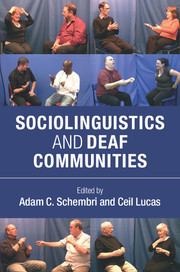Book contents
- Frontmatter
- Contents
- List of Figures
- List of Tables
- Notes on Contributors
- 1 Introduction
- 2 Sign languages in the world
- 3 Sign languages in contact
- 4 Variation and change in sign languages
- 5 Discourse analysis and sign languages
- 6 Language policy and planning in Deaf communities
- 7 Language attitudes in Deaf communities
- Index
- References
2 - Sign languages in the world
Published online by Cambridge University Press: 05 February 2015
- Frontmatter
- Contents
- List of Figures
- List of Tables
- Notes on Contributors
- 1 Introduction
- 2 Sign languages in the world
- 3 Sign languages in contact
- 4 Variation and change in sign languages
- 5 Discourse analysis and sign languages
- 6 Language policy and planning in Deaf communities
- 7 Language attitudes in Deaf communities
- Index
- References
Summary
What is multilingualism?
Multilingualism, the use of two or more languages by an individual or a community is described as a ‘powerful fact of life around the world’ (Edwards 1994). If we consider that there are an estimated 195 countries in the world today against the 7,106 living languages listed in the Ethnologue, we might assume that for most of the world's population, multilingualism is a common occurrence (Lewis, Simons, and Fennig 2013). But what do we mean by multilingualism? Research in this field is interested in how languages coexist alongside other languages and the factors that contribute to the various multilingual environments throughout the world. For example, people who know more than one language may or may not be equally proficient in each of their languages; they may only be as proficient as is necessary and their use of different languages may be confined to specific social settings or groups. The extent to which these language communities interact with one another may also vary. Additionally, some languages may not have any official recognition within the nation states in which they are found, and this may affect how these languages are perceived by others.
When we consider sign languages, we find many examples of multilingualism that parallel those described for spoken languages. In this chapter, we describe how multilingualism is a fact of life for nearly (if not all) signing individuals. We begin with a brief description of sign language as languages in their own right followed by a description of the different environments in which sign languages can thrive and the patterns of transmission that define them so that one can appreciate where, why, and how sign languages exist today. We also describe the types of multilingual environments that characterize the lives of deaf individuals and the factors that contribute to or against multilingualism.
- Type
- Chapter
- Information
- Sociolinguistics and Deaf Communities , pp. 5 - 28Publisher: Cambridge University PressPrint publication year: 2015
References
- 19
- Cited by



